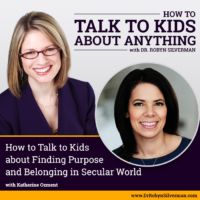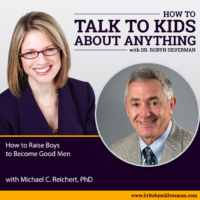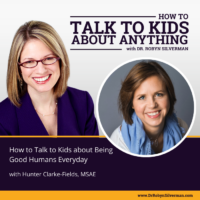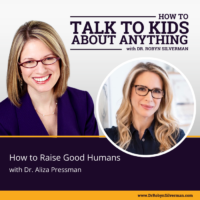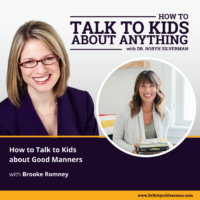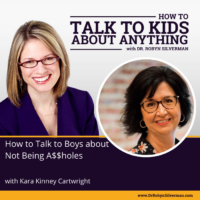Podcast: Play in new window | Download
Subscribe: Apple Podcasts | RSS | More
The Good News about Bad Behavior
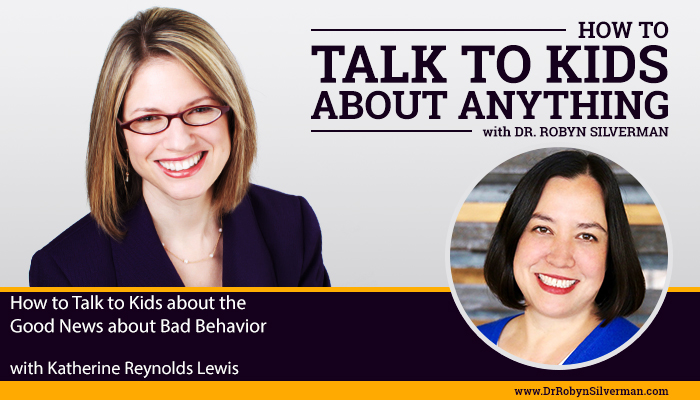
This podcast will focus on the good news about bad behavior! Looking into some of the top parenting models, Katherine Reynolds Lewis and Dr. Robyn Silverman discuss how best to help our children thrive in different situations. Inspired by parenting models from authors and podcast guests, Dr. Ross Greene and Vicki Hoefle (among others), we discuss how to best handle different scenarios that are common in households across the world. Ultimately, we want to use connection and communication to help children learn strategies that help them to become more capable—and also allow them to learn self-regulation.
Special guest: Katherine Reynolds Lewis.
There is a new and surprising problem that has quietly but perhaps not unnotably come to fruition during more recent years—our  children are out of control in comparison to previous generations. It’s not your imagination. A recent study of first-graders found that they could sit still for no more than three minutes—which is actually only a quarter of the time that their peers could in 1948. Government statistics show that half of all children will develop a mood or behavioral disorder or a substance addiction by age 18. What the heck is going on? I receive questions through Facebook, Instagram, Twitter and email all asking about what parents, teachers and coaches can do to get children to behave better. The old methods of rewards and punishments—star charts and time outs are not working. Are your ears perking up? We’ve all seen it and you are not alone.
children are out of control in comparison to previous generations. It’s not your imagination. A recent study of first-graders found that they could sit still for no more than three minutes—which is actually only a quarter of the time that their peers could in 1948. Government statistics show that half of all children will develop a mood or behavioral disorder or a substance addiction by age 18. What the heck is going on? I receive questions through Facebook, Instagram, Twitter and email all asking about what parents, teachers and coaches can do to get children to behave better. The old methods of rewards and punishments—star charts and time outs are not working. Are your ears perking up? We’ve all seen it and you are not alone.
My next guest has some good news about bad behavior—and some great tips and scripts to help us better understand our children and how to help our children learn to self–regulate.
Katherine Reynolds Lewis is an award-winning journalist and author of The Good News About Bad Behavior: Why Kids Are Less Disciplined Than Ever – And What to Do About It. Her work has appeared in the Atlantic, Fortune, Money, Mother Jones, The New York Times, Parade, Slate, USA Today’s magazine group, the Washington Post Magazine and Working Mother. She’s an EWA Education Reporting Fellow and Logan Nonfiction Fellow at the Carey Institute for Global Good. Residencies include the Virginia Center for the Creative Arts and Ragdale. Previously, Katherine was a national correspondent for Newhouse and Bloomberg News, covering everything from financial and media policy to the White House. She holds a BA in physics from Harvard University and is a certified parent educator with the Parent Encouragement Program (PEP) in Kensington, Md. She and her husband Brian are the proud parents of three children, 25, 14 and 12 years old.
The podcast provides:
- Why we are facing a crisis of self-regulation now—and what we can do about it.
- Why time-outs don’t work.
- The most powerful tools we can use with children to help with behavior and wellbeing?
- Why we must give up the goal of being the “perfect parent” and how making mistakes is helpful to raising well-adjusted kids.
- How to use the “Apprenticeship model.”
- How to respond when a child makes a poor behavioral choice such as throwing toys/chairs, not going to bed when it’s time, pushing back when asked to shut off screen-time.
- What to do when a child is having trouble in school.
Important Messages:
 Katherine investigated Dr. Greene’s model (see Dr. Green’s interview on the podcast here-> DrRobynSilverman.com/RGreene_PC) up in Maine. This sparked a viral article on Mother Jones and then, the book.
Katherine investigated Dr. Greene’s model (see Dr. Green’s interview on the podcast here-> DrRobynSilverman.com/RGreene_PC) up in Maine. This sparked a viral article on Mother Jones and then, the book.- In the book, Katherine looked into 4 different models- Dr. Greene’s model, the Pax Good Behavior Game, Parent Encouragement Program, Vicki Hoefle (Duct Tape Parenting).
- Is there something different about kids today? What can we do about it? These are the key questions Katherine sought to answer.
- 1 in 2 kids will be diagnosed with a mood or behavioral disorder by age 18.
- The suicide rates have doubled in the last decade (ages 10-14 years old) according to the CDC. Increased 41% in kids ages 15-19.
- 3 common elements in parenting models that work: (1) Focus on connection between the adult and child (2) Communication between the adult and child (3) Capability building- growing life skills and social-emotional skills.
- Neuroscience- when they are dysregulated and in flight or flight- their amygdala lights up. They are not able to access the prefrontal cortex. Our goal is to help them self-regulate and problem-solve- and make a plan for next time- and understand what’s happening with them in their brains.
- For example, child is using the ipad when s/he is not supposed to do so. If we lean into them and start yelling, they get amped up, the amydala starts going into fight or flight. Get zen, connect (arm around them), empathy for what they are doing, then move on to communication. “Wow! You are still doing fortnite? I thought you had moved on from that already.” Then go to the communication piece. You can put your hand out- that pressure can make it so your child responds- without arguing. You can discuss after “We had a problem- are you able to use devises on a school day or should we reserve them for the weekend?” Problem-solve.
- You can also have a consequence. Agreed-upon. Matter-of-fact. You lose 15 min of screen-time.
- We need to have the courage to be imperfect, to try something new and fail and to recognize that something we are doing is not working. Because- (1) We are imperfect. (2) We are the model. Show them how to respond to stress and messing up.
- Apprenticeship model- we don’t expect our children to be great at these skills already—they are learning, we are coaching, we are mentoring.
- In previous generations, there was a lot more autonomy. Kids had the chance to try things and mess up and try again. They weren’t overscheduled- they got to play. We need to take more of a mentoring role—let the be your apprenticeship.
- What does it feel like when you are having a panic attack? Let’s brainstorm 10 things you can do when this happens again—tools in THEIR toolbox. What worked? What didn’t work? They can get better and better.
- Child throws a chair: Safety first. Dr. Greene’s mode- coactive solutions. What happened? What made you throw a chair? How did YOU feel? How did YOU experience it? What is a solutions you can use for next time so you don’t get to that point again? If they are unsure, you can wait. Or you can reflect back—“From your body and your voice, it looks like this is an uncomfortable conversation for you. Do y0u think you are in trouble? This is not about being in trouble. I’m not angry- I want to find a solution with you.” You can apologize- “I’m sorry that I didn’t notice you were so worked up before you threw that chair…” You are not leaving the child blameless but you are taking on part of the responsibility and ownership of the problem and the solution. You can also say; “Take a guess. I’m not you, I’m not in your body or in your mind…or know what it’s like for you. We can always try it.” Or “if a friend of yours was in the same situation, what do you think would help him?”
- Sleeping issues: Don’t yell BUT don’t give in- don’t lie down with them or let them stay up.
- Script: (used at a different time than bedtime) “We know you guys love to connect around bedtime. For us, that’s a cooling down time from our day. We need adult time. After 8pm, we are going to be doing our winding down time- reading a book and connecting with each other during adult time. Before 8pm, we’d love to read you a story, talk about your day, cuddle, brush teeth together—but after 8pm, we’re going to be offline.” Then they agree. Put it in place and let it play out. After 8pm- don’t engage. “We’re off-duty.” Then, ignore. Then, they became much more aware of the time. Respectful of the child but also of the parents.
- Sibling rivalry is how kids learn social skills. It’s great practice—conflict resolution, negotiation, compromise. Stay out of it!
- Some people say; “all fighting must happen outside.” If you can’t resolve it quietly inside, you must go out on the front lawn.
- Strategy: Everyone in the same boat. “It looks like the remote control is causing a fight. I’m going to put it away. If you can resolve it calmly amongst yourselves, you can have it back.” The toy- or object is the problem.
- Strategy- talk it out. “It seems like you’ve been fighting a lot lately. Can I help with that?”
- Build your child’s awareness. Learn about themselves.
- Raising Awareness: Ask questions. “I hear you saying you don’t want to go to school. In the past, you have enjoyed it. What’s going on? What’s changed for you? What’s it like for you?” “I hear that this is hard for you. I’m not there with you in school- so paint me a picture—and tell me about one thing that’s hard for you in school.” (The kids are annoying, the teacher is annoying….) “OK- so the teacher is annoying. What did s/he say? What did you do? What do you think the teacher was thinking—why did s/he do what s/he did?” (Thank child for sharing it with you).
- “Is there one thing you can do tomorrow that would make things easier for you? Better for you?” Then follow up. Did you do that thing? Did it help? May take a while before they understand their role.
- Use reflective listening. How was this? It sounds like…
- Our children are not broken. Not flawed. Every human being has a unique mix of brain construction.
Notable Quotables:
-
 “1 in 2 kids will have a mood or behavioral disorder by age 18.” (NIH- representative sample of more than 10K kids).
“1 in 2 kids will have a mood or behavioral disorder by age 18.” (NIH- representative sample of more than 10K kids). - “Suicide rates have doubled in the last decade for kids ages 10-14 years old and have increased 41% in kids ages 13-19 years old. That’s an epidemic. Our children are dying because they can’t control their big emotions or their worried thoughts, or their troublesome behavior. Something needs to be done differently.”
- “We want to be worked out of a job—when we, as parents, are no longer in charge of them, we aren’t controlling them and we aren’t telling them what to do because they have self-discipline.
- “When we can use connection, communication and capability in a solution to a child’s behavior—that is what is going to grow their self-regulatory skills.
- “Our kids need to make friends with making mistakes and failure—and we need to as well. We need to have the courage to be imperfect, to try something new and fail and to recognize that something we are doing is not working.”
- “Trying to be perfect is responsible for a lot of our bad parenting decisions.”
- “Our solutions need to be respectful of the child but also of the adults and our needs.”
- “Nagging your children is engaging with them.”
- “I have the cure for sibling rivalry: Have an only child.”
- “Sibling rivalry is how kids learn social skills.”
- “This is a long-term process: Our children learning about themselves, gaining awareness, and changing or modifying their behavior.”
- “The good news about bad behavior is that it signals to the adult that the child needs a skill for that situation—it’s a big red flag but it’s also a big opportunity for growing that child’s skills. It allows you to understand what’s getting in the child’s way and work with them on their behavior.”
- “Every human being has a unique mix of brain chemistry—and our kids are just the same. They need us to work with them as detectives, helping them to figure out what strategies and tools work for me? What helps me to thrive?”
The good news about bad behavior is that while it’s a big red flag, it’s also a big opportunity for growing that child’s skills, says @KatherineLewis on #talktokids podcast. Find out what we can do to help our kids thrive.
Click To Tweet
Resources:
- KatherineLewis.com
- The Good News about Bad Behavior (Amazon book)
- Mother Jones article: https://www.motherjones.com/politics/2015/07/schools-behavior-discipline-collaborative-proactive-solutions-ross-greene/
- Dr. Greene’s #Talktokids interview: DrRobynSilverman.com/RGreene_PC
- Pax Good Behavior Game: https://www.goodbehaviorgame.org/
- Parent Encouragement Program: http://pepparent.org/
- Vicki Hoefle interview on #talktokids will be next week! Check back!
Social Media for Dr. Robyn:
- facebook.com/DrRobynSilverman
- twitter.com/DrRobyn
- instagram.com/DrRobynSilverman
- facebook.com/HowToTalkToKidsaboutAnything
The post The Good News about Bad Behavior with Katherine Reynolds Lewis – ReRelease appeared first on drrobynsilverman.com.

